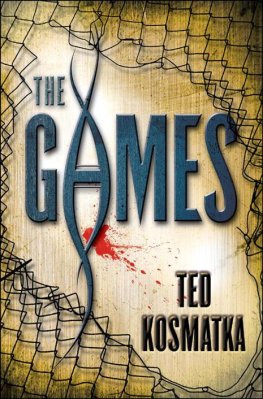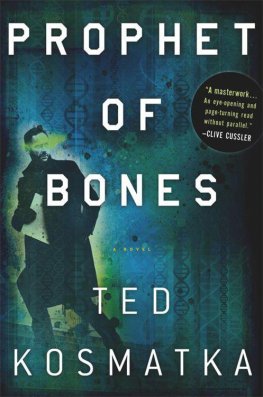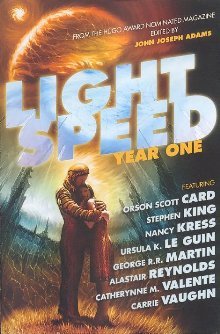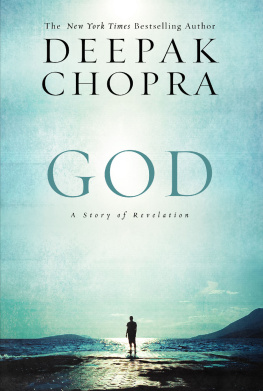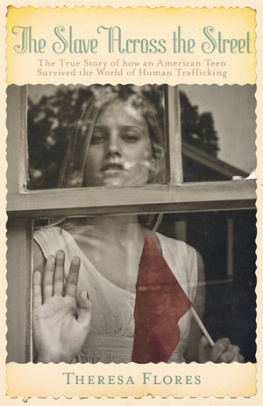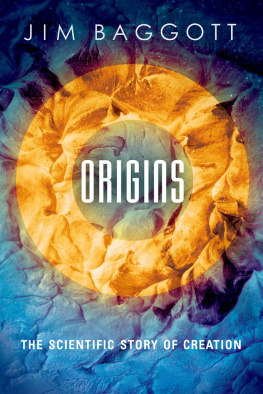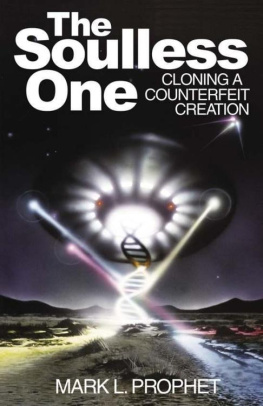Ted Kosmatka - The Prophet of Flores
Here you can read online Ted Kosmatka - The Prophet of Flores full text of the book (entire story) in english for free. Download pdf and epub, get meaning, cover and reviews about this ebook. year: 2007, publisher: Asimov's Science Fiction, September 2007, genre: Science fiction. Description of the work, (preface) as well as reviews are available. Best literature library LitArk.com created for fans of good reading and offers a wide selection of genres:
Romance novel
Science fiction
Adventure
Detective
Science
History
Home and family
Prose
Art
Politics
Computer
Non-fiction
Religion
Business
Children
Humor
Choose a favorite category and find really read worthwhile books. Enjoy immersion in the world of imagination, feel the emotions of the characters or learn something new for yourself, make an fascinating discovery.

- Book:The Prophet of Flores
- Author:
- Publisher:Asimov's Science Fiction, September 2007
- Genre:
- Year:2007
- Rating:3 / 5
- Favourites:Add to favourites
- Your mark:
- 60
- 1
- 2
- 3
- 4
- 5
The Prophet of Flores: summary, description and annotation
We offer to read an annotation, description, summary or preface (depends on what the author of the book "The Prophet of Flores" wrote himself). If you haven't found the necessary information about the book — write in the comments, we will try to find it.
The Prophet of Flores — read online for free the complete book (whole text) full work
Below is the text of the book, divided by pages. System saving the place of the last page read, allows you to conveniently read the book "The Prophet of Flores" online for free, without having to search again every time where you left off. Put a bookmark, and you can go to the page where you finished reading at any time.
Font size:
Interval:
Bookmark:
The Prophet of Flores
by Ted Kosmatka
If this is the best of all possible worlds, what are the others like?
VoltaireWhen Paul was a boy, he played God in the attic above his parents garage. Thats what his father called it, playing God, the day he found out. Thats what he called it the day he smashed it all down.
Paul built the cages out of discarded two-by-fours hed found behind the garage, and quarter-inch mesh he bought from the local hardware store. While his father was away speaking at a scientific conference on divine cladistics, Paul began constructing his laboratory from plans hed drawn during the last day of school.
Because he wasnt old enough to use his fathers power tools, he had to use a handsaw to cut the wood for the cages. He used his mothers sturdy black scissors to snip the wire mesh. He borrowed hinges from old cabinet doors, and he borrowed nails from the rusty coffee can that hung over his fathers unused workbench.
One evening his mother heard the hammering and came out to the garage. What are you doing up there? she asked, speaking in careful English, peering up at the rectangle of light that spilled down from the attic.
Paul stuck his head through the opening, all spiky black hair and sawdust. Im just playing around with some tools, he said. Which was, in some sense, the truth. Because he couldnt lie to his mother. Not directly.
Which tools? Just a hammer and some nails.
She stared up at him, her delicate face a broken Chinese dollpieces of porcelain re-glued subtly out of alignment. Be careful, she said, and he understood she was talking both about the tools and about his father.
I will.
The days turned into weeks as Paul worked on the cages. Because the materials were big, he built the cages bigless cutting that way. In reality, the cages were enormous, over-engineered structures, ridiculously outsized for the animals theyd be holding. They werent mouse cages so much as mouse citieshuge tabletop-sized enclosures that could have housed German Shepherds. He spent most of his paper route money on the project, buying odds and ends that he needed: sheets of plexi, plastic water bottles, and small dowels of wood he used for door latches. While the other children in the neighborhood played basketball or wittedandu, Paul worked.
He bought exercise wheels and built walkways; he hung loops of yarn the mice could climb to various platforms. The mice themselves he bought from a pet store near his paper route. Most were white feeder mice used for snakes, but a couple were of the more colorful, fancy variety. And there were even a few English micesleek, long-bodied show mice with big tulip ears and glossy coats. He wanted a diverse population, so he was careful to buy different kinds.
While he worked on their permanent homes, he kept the mice in little aquariums stacked on a table in the middle of the room. On the day he finished the last of the big cages, he released the mice into their new habitats one by onethe first explorers on a new continent. To mark the occasion, he brought his friend John over, whose eyes grew wide when he saw what Paul had made.
You built all this? John asked.
Yeah.
It must have taken you a long time.
Months.
My parents dont let me have pets.
Neither do mine, Paul answered. But anyway, these arent pets.
Then what are they?
An experiment.
What kind of experiment?
I havent figured that out yet.
* * *Mr. Finley stood at the projector, marking a red ellipse on the clear plastic sheet. Projected on the wall, it looked like a crooked half-smile between the X and Y axis.
This represents the number of daughter atoms. And this He drew the mirror image of the first ellipse. This is the number of parent atoms. He placed the marker on the projector and considered the rows of students. Can anyone tell me what the point of intersection represents?
Darren Michaels in the front row raised his hand. Its the elements half-life.
Exactly. Johnson, in what year was radiometric dating invented?
1906.
By whom?
Rutherford.
What method did he use?
Uranium lead
No. Wallace, can you tell us?
He measured helium as an intermediate decay product of uranium.
Good, so then who used the uranium-lead method?
That was Boltwood, in 1907.
And how were these initial results viewed?
With skepticism.
By whom?
By the evolutionists.
Good. Mr. Finley turned to Paul. Carlson, can you tell us what year Darwin wrote On the Origin of Species?
1867, Paul said.
Yes, and in what year did Darwins theory finally lose the confidence of the larger scientific community?
That was 1932. Anticipating his next question, Paul continued. When Kohlhorster invented potassium-argon dating. The new dating method proved the earth wasnt as old as the evolutionists thought.
And in what year was the theory of evolution finally debunked completely?
1954, when Willard F. Libby invented carbon-14 dating at the University of Chicago. He won the Nobel prize in 1960 when he used carbon dating to prove, once and for all, that the Earth was 5,800 years old.
* * *Paul wore a white lab coat when he entered the attic. It was one of his fathers old coats, so he had to cut the sleeves to fit his arms. Pauls father was a doctor, the Ph.D kind. He was blond and big and successful. Hed met Pauls mother after grad school while consulting for a Chinese research firm. They had worked on the same projects for a while, but there was never any doubt that Pauls father was the bright light of the family. The genius, the famous man. He was also crazy.
Pauls father liked breaking things. He broke telephones, and he broke walls, and he broke tables. He broke promises not to hit again. One time, he broke bones; the police were called by the ER physicians who did not believe the story about Pauls mother falling down the stairs. They did not believe the weeping woman of porcelain who swore her husband had not touched her.
Pauls father was a force of nature, a cataclysm; as unpredictable as a comet strike or a volcanic eruption. The attic was a good place to hide, and Paul threw himself into his hobby.
Paul studied his mice as though they were Goodalls chimps. He documented their social interactions in a green spiral notebook. He found that, within the large habitats, they formed packs like wolves, with a dominant male and a dominant femalea structured social hierarchy involving mating privileges, territory, and almost-ritualized displays of submission by males of lower rank. The dominant male bred most of the females, and mice, Timothy learned, could kill each other.
Nature abhors a vacuum, and the mouse populations expanded to fill the new worlds hed created for them. The babies were born pink and blind, but as their fur came in, Paul began documenting colors in his notebook. There were fawns, blacks, and grays. Occasional agoutis. There were Irish spotted, and banded, and broken marked. In later generations, colors appeared that he hadnt purchased, and he knew enough about genetics to realize these were recessive genes cropping up.
Paul was fascinated by the concept of genes, the stable elements through which God provided for the transfer of heritable characteristics from one generation to the next. In school they called it divine transmission.
Paul did research and found that the pigmentation loci of mice were well-mapped and well-understood. He categorized his population by phenotype and found one mouse, a pale, dark-eyed cream that must have been a triple recessive: bb, dd, ee. But it wasnt enough to just have them, to observe them, to run the Punnett squares. He wanted to do real science. Because real scientists used microscopes and electronic scales, Paul asked for these things for Christmas.
Font size:
Interval:
Bookmark:
Similar books «The Prophet of Flores»
Look at similar books to The Prophet of Flores. We have selected literature similar in name and meaning in the hope of providing readers with more options to find new, interesting, not yet read works.
Discussion, reviews of the book The Prophet of Flores and just readers' own opinions. Leave your comments, write what you think about the work, its meaning or the main characters. Specify what exactly you liked and what you didn't like, and why you think so.

